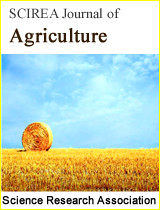Identification of 2,5-dimethyl-3-furanthiol in coffee by two dimensional GC TOF MS
DOI: 10.54647/agriculture210342 141 Downloads 161716 Views
Author(s)
Abstract
2,5-dimethyl-3-furanthiol is an important aroma constituent widely used in flavorings for food stuff. While its occurrence in food is mentioned several times, its unequivocal identification is not clear. In an SDE extract of ground coffee beans, using a pre-separation step and two dimensional GC TOF MS, its occurrence in ground coffee was confirmed. Targeted analysis with modern instrumentation proved to be a powerful technique to detect such a minor constituent in a complex matrix.
Keywords
2,5-dimethyl-3-furanthiol, coffee, GC TOF MS
Cite this paper
Eric Houben, Klaus Gassenmeier,
Identification of 2,5-dimethyl-3-furanthiol in coffee by two dimensional GC TOF MS
, SCIREA Journal of Agriculture.
Volume 8, Issue 2, April 2023 | PP. 97-105.
10.54647/agriculture210342
References
| [ 1 ] | Gasser, U.; Grosch, W. Primary Odorants of Chicken Broth. Z. Lebensm. Unters. Forsch. 1990, 190, 3-8. https://doi.org/10.1007/BF01188254 |
| [ 2 ] | Oser, B.L.; Ford, R.A. Recent progress it the consideration of flavoring ingredients under the food additives amendment. 9. GRAS Substances. Food Technol. 1975, 29, 70-72. |
| [ 3 ] | Giri, A.; Khummueng, W.; Mercier, F.; Kondjoyan, N.; Tournayre, P.; Meurillon, M.; Ratel, J.; Engel, E. Relevance of two-dimensional gas chromatography and high resolution olfactometry for the parallel determination of heat-induced toxicants and odorants in cooked food. J. Chromatogr. A 2015, 1388, 217–226. https://doi.org/10.1016/j.chroma.2015.01.045 |
| [ 4 ] | Quintanilla-Casas, B.; Dulsat-Serra, N.; Cortes-Francisco, N.; Caixach, J.; Vichi, S. Thiols in brewed coffee: Assessment by fast derivatization and liquid Chromatography - high resolution mass spectrometry. LWT - Food Sci. Technol. 2015, 64, 1085-1090. https://doi.org/10.1016/j.lwt.2015.07.010. |
| [ 5 ] | Majcher, M.; Jeleń, H.H. Comparison of suitability of SPME, SAFE and SDE methods for isolation of flavor compounds from extruded potato snacks. J. Food Compos. Anal. 2009, 22, 606-612. https://doi.org/10.1016/j.jfca.2008.11.006 |
| [ 6 ] | International Organization of the Flavour Industry (I. O. F. I.). Statement on the identification in nature of flavouring substances, made by the Working Group on Methods of Analysis of the International Organization of the Flavour Industry (IOFI). Flavour Fragr. J. 2006, 21, 185. https://doi.org/10.1002/ffj.1721 |
| [ 7 ] | Ishikawa, M.; Ito, O.; Ishizaki, S.; Kurobayashi, Y.; Fujita, A. Solid-phase aroma concentrate extraction (SPACE™ ): a new headspace technique for more sensitive analysis of volatiles. Flavour Fragr. J. 2004, 19, 183–187. https://doi.org/10.1002/ffj.1322. |
| [ 8 ] | Silwar, R. Gaschromatographisch-massenspektrometrische Untersuchung der im Modellsystem Cystein/Rhamnose unter Röstbedingungen gebildeten Aromastoffe. Z. Lebensm. Unters. Forsch. 1992, 195, 112-119. https://doi.org/10.1007/BF01201769 |
| [ 9 ] | Hartman, G.J.; Carlin, J.T.; Scheide, J.D.; Ho, C.T. Volatile products formed from the thermal degradation of thiamin at high and low moisture levels. J. Agric. Food Chem. 1984, 32, 1015-1018. https://doi.org/10.1021/jf00125a016 |
| [ 10 ] | Hofmann, T.; Schieberle, P. Quantitative model studies on the effectiveness of different precursor systems in the formation of the intense food odorants 2-furfurylthiol and 2-methyl-3-furanthiol. J. Agric. Food Chem. 1998, 46, 235−241. https://doi.org/10.1021/jf9705983 |

